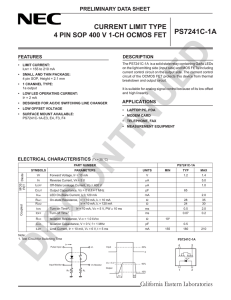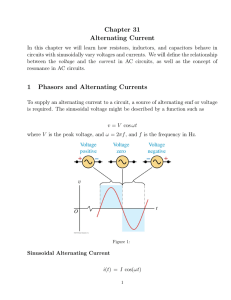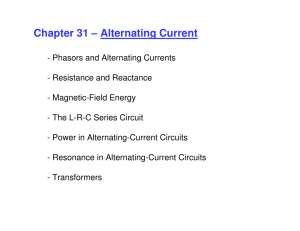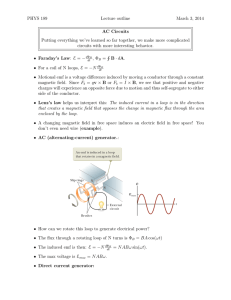AC circuits
advertisement
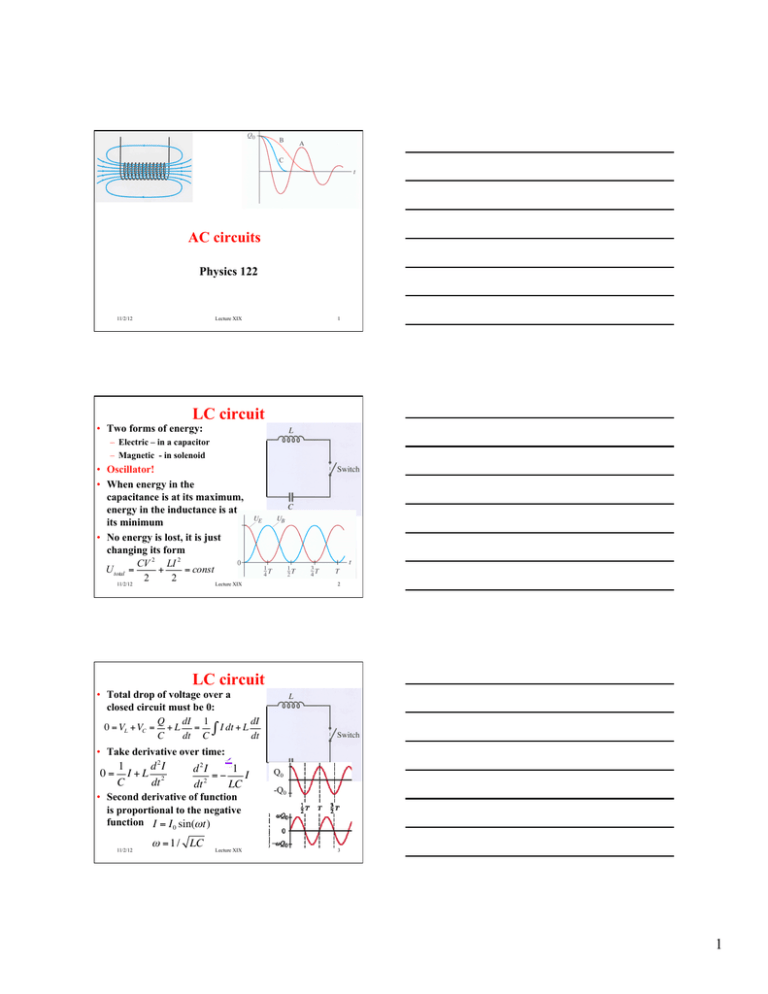
AC circuits Physics 122 11/2/12 Lecture XIX 1 LC circuit • Two forms of energy: – Electric – in a capacitor – Magnetic - in solenoid • Oscillator! • When energy in the capacitance is at its maximum, energy in the inductance is at its minimum • No energy is lost, it is just changing its form CV 2 LI 2 U total = + = const 2 2 11/2/12 Lecture XIX 2 LC circuit • Total drop of voltage over a closed circuit must be 0: Q dI 1 dI 0 = VL +VC = + L = ∫ I dt + L C dt C dt • Take derivative over time: 0= 1 d 2I I+L 2 C dt d 2I 1 =− I 2 dt LC • Second derivative of function is proportional to the negative function I = I 0 sin(ω t) 11/2/12 ω = 1 / LC Lecture XIX Q0 -Q0 3 1 LCR circuit • Resistors dissipate energy – Convert electrical energy into thermal energy • Resistor acts like friction for a weight on a spring • Damped oscillator! 11/2/12 Lecture XVIII 4 Inductance • Magnetic field in a solenoid B∝I • It creates a magnetic flux through itself dΦ dB dI Φ = BA ∝ ∝ dt dt dt • Changing magnetic flux generates emf (voltage gained) = -drop of Voltage (voltage lost) emf = −VL = − N 11/2/12 Lecture XIX dΦ dI = −L dt dt 5 AC circuits • External source of alternating voltage V(t)=V0sinωt – Forced oscillator • Frequency f, cyclic frequency ω=2πf • Active elements – Inductors – Capacitors • Passive elements – Resistors 11/2/12 Lecture XIX 6 2 Phasor diagram • Graphical way to present current and voltage in AC circuit y • Present current and voltage in a certain element (resistor, I (t ) = I 0 ⋅ sin(ω t ) inductance, capacitance) as vectors rotating in (x,y) plane • Vector length is equal to maximum possible value of I or V: I0 and V0 • Vector projection on y-axis is equal to the value of current or voltage at the moment t 11/2/12 I0 ωt x Lecture XIX 7 Current and voltage in AC circuit y I0 I (t ) = I 0 ⋅ sin(ω t ) VR (t ) = V0 sin(ω t ) Vo ωt x V0 = RI 0 Drop of voltage over resistor (V) follows I Current and voltage in phase 11/2/12 Lecture XIX 8 Current and voltage in AC circuit dI dt d sin(ω t ) VL = LI 0 = Lω I 0 cos(ω t ) dt VL = Lω I 0 sin(ω t + 90 0 ) VL = L V0 = X L I 0 X L = Lω 11/2/12 y I0 I (t ) = I 0 ⋅ sin(ω t ) VR (t ) = V0 cos(ω t ) Vo ωt x Lecture XIX Inductor: current lags voltage 9 3 Current and voltage in AC circuit Q 1 = ∫ I dt C C 1 1 VC = ∫ I 0 sin(ω t)dt = − I 0 cos(ω t) C ωC y 1 I ( t ) = I ⋅ sin( ω t) 0 V0 = I 0 = XC I 0 ωC V VC = o XC = 1 ωC I0 ωt x VR (t ) = −V0 cos(ω t ) Capacitor: voltage lags current 11/2/12 Lecture XIX 10 LCR circuit y I0 I (t ) = I 0 ⋅ sin(ω t ) VL VR ωt VC x V0 R = I 0 R, R = R, Ohm’s law!! V0 L = I 0 X L , X L = ω L, V0C = I 0 X C XC = "V " = "VR "+"VL "+"VC " = ZI 1 ωC Z − impedance 11/2/12 Lecture XIX 11 Impedance I0 y V0 VL VR VC V0 =| Z | I 0 | Z |= R 2 + (X L − XC )2 tan φ = (X L − XC ) / R 11/2/12 x This equation relates maximum voltage to maximum current. Mind, that they do not happen at the same time. There is a phase shift between Imax and Vmax -φ Lecture XIX 12 4 Phase angle and power factor X L − XC R R cos ϕ = Z tan ϕ = V0 VL φ I0 VR VC Vrms = ZI rms P ="V ⋅ I " = Vrms I rms cos φ x Cosφ – power factor NB. V and I are not real vectors, only in phasor diagram representation. 11/2/12 Lecture XIX 13 Energy in AC circuit Total average power in AC P = Vrms I rms cos φ Power dissipated only in resistors: 2 P = I rms R 11/2/12 Lecture XIX 14 Resonance in LCR circuit I rms V = rms Z Z = R 2 + ( X L − X C )2 • Largest current when impedance is the smallest • XL, XC are functions of frequency • At a certain frequency X = X L C ωL= ω= 11/2/12 1 ωC 1 LC Lecture XIX f = 1 2π LC 15 5
